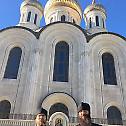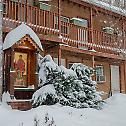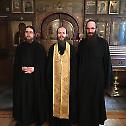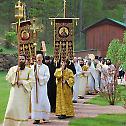Science
Apostle Matthias of the Seventy
23. August 2018 - 15:28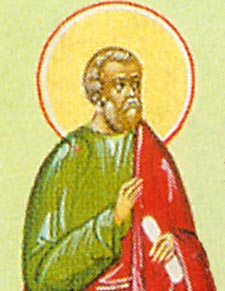 The Holy Apostle Matthias was born at Bethlehem of the Tribe of Judah. From his early childhood he studied the Law of God under the guidance of Saint Simeon the God-Receiver (February 3).
The Holy Apostle Matthias was born at Bethlehem of the Tribe of Judah. From his early childhood he studied the Law of God under the guidance of Saint Simeon the God-Receiver (February 3).
When the Lord Jesus Christ revealed Himself to the world, Saint Matthias believed in Him as the Messiah, followed constantly after Him and was numbered among the Seventy Apostles, whom the Lord “sent them two by two before His face” (Luke 10:1).
After the Ascension of the Savior, Saint Matthias was chosen by lot to replace Judas Iscariot as one of the Twelve Apostles (Acts 1:15-26). After the Descent of the Holy Spirit, the Apostle Matthias preached the Gospel at Jerusalem and in Judea together with the other Apostles (Acts 6:2, 8:14). From Jerusalem he went with the Apostles Peter and Andrew to Syrian Antioch, and was in the Cappadocian city of Tianum and Sinope. Here the Apostle Matthias was locked into prison, from which he was miraculously freed by Saint Andrew the First-Called.
Transfiguration
19. August 2018 - 1:04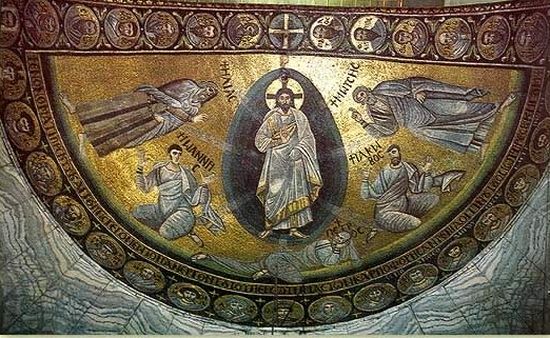 The transfiguration of Christ is one of the central events recorded in the gospels. Immediately after the Lord was recognized by his apostles as “the Christ [Messiah], the Son of the Living God,” he told them that “he must go up to Jerusalem and suffer many things ... and be killed and on the third day be raised” (Mt 16). The announcement of Christ’s approaching passion and death was met with indignation by the disciples. And then, after rebuking them, the Lord took Peter, James, and John “up to a high mountain”—by tradition Mount Tabor—and was “transfigured before them.”
The transfiguration of Christ is one of the central events recorded in the gospels. Immediately after the Lord was recognized by his apostles as “the Christ [Messiah], the Son of the Living God,” he told them that “he must go up to Jerusalem and suffer many things ... and be killed and on the third day be raised” (Mt 16). The announcement of Christ’s approaching passion and death was met with indignation by the disciples. And then, after rebuking them, the Lord took Peter, James, and John “up to a high mountain”—by tradition Mount Tabor—and was “transfigured before them.”
Martyr Parasceva of Rome
8. August 2018 - 15:59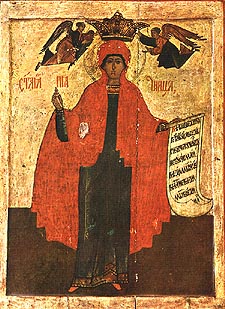 Holy Virgin Martyr Paraskeva of Rome was the only daughter of Christian parents, Agathon and Politia, and from her early years she dedicated herself to God. She spent much of her time in prayer and the study of the Holy Scriptures. After the death of her parents Saint Paraskeva distributed all of her inheritance to the poor, and consecrated her virginity to Christ. Emulating the holy Apostles, she began to preach to the pagans about Christ, converting many to Christianity.
Holy Virgin Martyr Paraskeva of Rome was the only daughter of Christian parents, Agathon and Politia, and from her early years she dedicated herself to God. She spent much of her time in prayer and the study of the Holy Scriptures. After the death of her parents Saint Paraskeva distributed all of her inheritance to the poor, and consecrated her virginity to Christ. Emulating the holy Apostles, she began to preach to the pagans about Christ, converting many to Christianity.
She was arrested during the reign of Antoninus Pius (138-161) because she refused to worship the idols. She was brought to trial and fearlessly confessed herself a Christian. Neither enticements of honors and material possessions, nor threats of torture and death shook the firmness of the saint nor turned her from Christ. She was given over to beastly tortures. They put a red-hot helmet on her head and threw her in a cauldron filled with boiling oil and pitch. By the power of God the holy martyr remained unharmed. When the emperor peered into the cauldron, Saint Paraskeva threw a drop of the hot liquid in his face, and he was burned. The emperor began to ask her for help, and the holy martyr healed him. After this the emperor set her free.
“We Work Out Our Salvation Together”
7. August 2018 - 8:46A Conversation with Two Monks from the Hermitage of the Holy Cross
Fr. Macarius (Ruegemer) and Fr. David (Mahand) are monks from the Hermitage of the Holy Cross in West Virginia. Fr. Macarius is a hierodeacon and Fr. David is a riassophore monk. Their abbot blessed them to travel to Russia to see and experience the monastic life there, first staying at Sretensky Monastery for a week, having been invited by one of the brethren, and then to visit Optina for two weeks. In this interview, we spoke with them about life in their monastery, the formation of novices, and the spiritual advice, and above all, spiritual joy that they receive from their abbot, Archimandrite Seraphim.
—Fr. David and Fr. Macarius, can you tell us a bit about your monastery?
—Fr. David: The monastery was founded in 1986 by Hieromonk Kallistos, who was a Greek-American hieromonk serving a parish in the Russian Church Abroad. He asked the bishop if he could have a blessing to start a small brotherhood and a small sisterhood because there were some men and some women interested in the monastic life, and so Vladyka Alipy blessed him to found a brotherhood and sisterhood. Fr. Kallistos asked if the brotherhood could be dedicated to the Exaltation of the Cross. Vladyka Alipy said yes, but that there should also be a patron saint, someone who the monks could have a relationship with and ask for prayers from, so Vladyka Alipy gave us St. Panteleimon, whom we consider our patron saint.
Tenth Sunday After Pentecost. The Healing of the Demoniac Boy
6. August 2018 - 13:42 Matthew 17:14-23. From The Explanation of the Gospel of St. Matthew by Blessed Theophylact, Archbishop of Ochrid and Bulgaria
Matthew 17:14-23. From The Explanation of the Gospel of St. Matthew by Blessed Theophylact, Archbishop of Ochrid and Bulgaria
Matthew 17:14-15 And when they were come to the multitude, there came to Him a certain man, kneeling down to Him, and saying, Lord, have mercy on my son: for he is lunatic, and sore vexed: for oftimes he falleth into the fire, and oft into the water.
That this man is exceedingly faithless is clear from the words which Christ spoke in reply to him, “O faithless generation,” and from the fact that the man himself blamed the disciples. The moon was not the cause, but rather, the demon would take note when the moon was full, and then would set upon his victim, so that men would blaspheme the created works of God as maleficent. You, then, O reader, understand that it is a foolish man that changes as the moon, as it is written,[1] at times waxing great in virtue, at other times waning and vanishing altogether. Then the foolish man becomes deranged and falls down into the fire of anger and lust, and into water, that is, the of the many cares of life, in which Leviathan the devil dwells, he who reigns over over the waters. For are not the cares of the rich like waves that follow each other in quick succession?
Myrrhbearer and Equal of the Apostles Mary Magdalene
30. July 2018 - 14:30The Holy Myrrh-Bearer Equal of the Apostles Mary Magdalene.
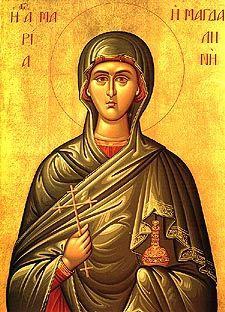 On the banks of Lake Genesareth (Galilee), between the cities of Capharnum and Tiberias, was the small city of Magdala, the remains of which have survived to our day. Now only the small village of Mejhdel stands on the site. A woman whose name has entered forever into the Gospel account was born and grew up in Magdala. The Gospel tells us nothing of Mary’s younger years, but Tradition informs us that Mary of Magdala was young and pretty, and led a sinful life. It says in the Gospels that the Lord expelled seven devils from Mary (Luke. 8:2). From the moment of her healing Mary led a new life, and became a true disciple of the Savior.
On the banks of Lake Genesareth (Galilee), between the cities of Capharnum and Tiberias, was the small city of Magdala, the remains of which have survived to our day. Now only the small village of Mejhdel stands on the site. A woman whose name has entered forever into the Gospel account was born and grew up in Magdala. The Gospel tells us nothing of Mary’s younger years, but Tradition informs us that Mary of Magdala was young and pretty, and led a sinful life. It says in the Gospels that the Lord expelled seven devils from Mary (Luke. 8:2). From the moment of her healing Mary led a new life, and became a true disciple of the Savior.
The Gospel relates that Mary followed after the Lord, when He went with the Apostles through the cities and villages of Judea and Galilee preaching about the Kingdom of God. Together with the pious women Joanna, wife of Choza (steward of Herod), Susanna and others, she served Him from her own possessions (Luke 8:1-3) and undoubtedly shared with the Apostles the evangelic tasks in common with the other women. The Evangelist Luke, evidently, has her in view together with the other women, stating that at the moment of the Procession of Christ onto Golgotha, when after the Scourging He took on Himself the heavy Cross, collapsing under its weight, the women followed after Him weeping and wailing, but He consoled them. The Gospel relates that Mary Magdalene was present on Golgotha at the moment of the Lord’s Crucifixion. While all the disciples of the Savior ran away, she remained fearlessly at the Cross together with the Mother of God and the Apostle John.

